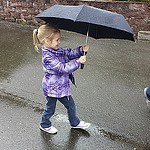Marking the casing stitching lines
-
12 years ago LINK
Maggie @Maggie
I don’t have a lot of experience with marking through a pattern, but this is what worked for me. I pierced the pattern every inch or so with a large darning needle. I was then able to stick my marking pen through the holes and mark dots on the fabric. I then connected the dots easily.
Perhaps it is time to invest in tailor’s chalk or wax marking paper.
12 years ago LINK meleliza
@meleliza
meleliza
@meleliza
The tracing paper doesn’t wash out, so you have to be a little careful where you use it. For the casings here, a ruler and pencil might do it? I haven’t seen the pattern yet though. Anyway, your method sounds like it worked well.
12 years ago LINK KarenK
@KarenK
KarenK
@KarenK
Great idea, Maggie.
I haven’t experienced tracings not washing out, at least not with the Dritz brand that is more like a chalk mark than wax. I use the lightest color possible while still allowing it to show enough to follow.
12 years ago LINKMaggie @Maggie
When I quilt sometimes I use a regular pencil to mark. I always have one, and it always washes out.
12 years ago LINKmkhs @mkhs
I am another who usually marks with a No.2 pencil, but I recently purchased a hera and am finding it very useful for things like this– also marking darts, etc. It doesn’t leave an actual mark, but an impression in the fabric.
http://www.amazon.com/Clover-490-NV-Hera-Marker/dp/B0011451F8
12 years ago LINK Nicole
@motherof5
Nicole
@motherof5
I do what you do Maggie!
12 years ago LINK sayiamyou
@maraya
sayiamyou
@maraya
So do I.
12 years ago LINK meleliza
@meleliza
meleliza
@meleliza
On the craftsy course, I watched Susan Khalje use a little chalk wheel to mark and now I love it too. It makes a nice mark on the fabric and you can easily brush it off with your hand when done. It’s great when you need to mark the right side. I use with a ruler too. Pretty sure it’s from dritz and I bought it at Joann.
12 years ago LINK meleliza
@meleliza
meleliza
@meleliza
I’ve been mening to add that I have been using my tracing wheel – the one Liesl sells here – without the waxed tracing paper to mark the stitching lines. For a lot of fabrics, the indentations it makes are enough. Also, the stitching lines are 5/8″ apart, so marking one line is also enough.ni use my markings on the machine to stitch the second line.
12 years ago LINK Jess M.
@mommy2maria
Jess M.
@mommy2maria
The Hera marker is perfect for this. I love love love my Hera.
11 years ago LINKMimmySews @MimmySews
I use Frixion markers. You have to be careful because they erase with the heat of the iron, but the lines reappear if you put the fabric in the freezer. Once the item is washed, the lines permanently disappear!..
Because I don’t sew curves well, I mark the seam line for the armholes before I stitch. The line disappears when I press the seam!
11 years ago LINK Sarvi
@Sarvi
Sarvi
@Sarvi
I was going to make a joke about how I’d make a note not to put my child in the freezer with her clothes on, but then I remembered that lots of folks live in places where the inside of the freezer is warmer than the air outside.
11 years ago LINKbren5kids @bren5kids
I use the same method as Maggie.
Mimmy, I didn’t know that Frixion markings will reappear if put in freezer! That’s good to know, because I have been quite annoyed when I accidently ironed over marking lines when I still needed them :-/
11 years ago LINK meleliza
@meleliza
meleliza
@meleliza
I have found that on some fabrics, I can see the marks from a tracing wheel without even using the tracing paper. Sometimes they’re a little hard to see, but better it’s still a simpler method than anything else I’ve been able to come up with. I really like this one for top stitching the Roller Skate casings. Or any other topstitching for that matter.
11 years ago LINKMimmySews @MimmySews
Reminds me of when my mom used to sprinkle the clothes, wrap them in plastic and put them in our teeny refrigerator. Here’s a demo. I like the pens cause they come in fine-point.
You must be logged in to reply to this topic.
copyright
Unless otherwise credited, all work on this blog is © Liesl + Co., Inc, 2008-2026. You are welcome to link to this blog, but please ask permission before using any text or images.